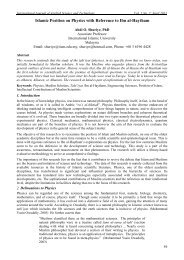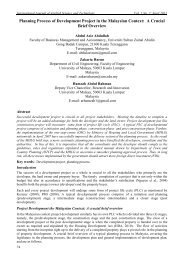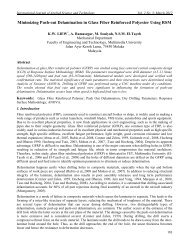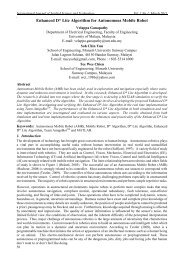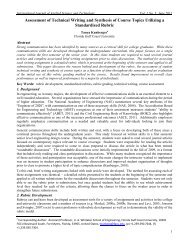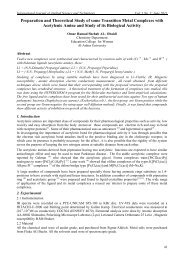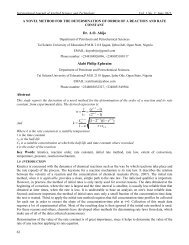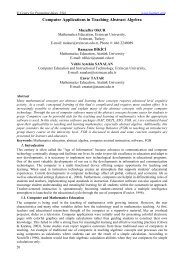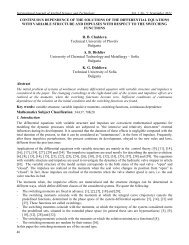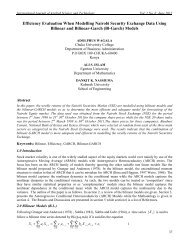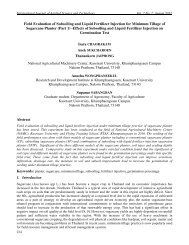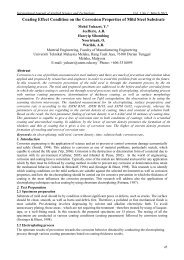On the Antenna Gain Formula - International Journal of Applied ...
On the Antenna Gain Formula - International Journal of Applied ...
On the Antenna Gain Formula - International Journal of Applied ...
Create successful ePaper yourself
Turn your PDF publications into a flip-book with our unique Google optimized e-Paper software.
© Centre for Promoting Ideas, USA www.ijastnet .com<br />
Where,<br />
R<br />
12<br />
<br />
30 2cosh( d)<br />
cosh[ (<br />
2<br />
,<br />
<br />
Method 2: General antenna gain<br />
d<br />
2<br />
L<br />
2<br />
L)]<br />
cosh[ (<br />
d<br />
2<br />
L<br />
2<br />
<br />
L)]<br />
,<br />
Applying <strong>the</strong> Friis transmission formula (Equation 6) to <strong>the</strong> gain-comparison formula (Equation 14) yields gain<br />
formula which can be used for all antennas and is given as:<br />
A<br />
( )<br />
10log<br />
10<br />
, (37)<br />
<br />
er AUT<br />
G<br />
<br />
AUT<br />
GS<br />
<br />
Aer(<br />
S ) <br />
4. Results and Discussion<br />
In this paper two formulas were derived for estimation <strong>of</strong> antenna gain. <strong>On</strong>e <strong>of</strong> <strong>the</strong> formulas is derived based on<br />
<strong>the</strong> method <strong>of</strong> gain in <strong>the</strong> field intensity <strong>of</strong> <strong>the</strong> array antenna earlier published by Kraus, 1988, and <strong>the</strong> formula is<br />
meant for array antenna gain. The second formula can be used to determine <strong>the</strong> gain <strong>of</strong> all antennas. It is derived<br />
based on <strong>the</strong> existing gain-comparison method. The two formulas were used to compute <strong>the</strong> gain <strong>of</strong> a two<br />
rectangular folded array antenna, as an example, using <strong>the</strong> /2 antenna as <strong>the</strong> reference isotropic antenna. The<br />
results <strong>of</strong> <strong>the</strong> computation were compared with <strong>the</strong> experimental measurement results <strong>of</strong> <strong>the</strong> antenna gain. It is<br />
observed that <strong>the</strong> normalized root-mean-square errors <strong>of</strong> 0.52% and 0.3% were obtained when <strong>the</strong> method 1 and<br />
method 2 were respectively compared with <strong>the</strong> measured gain <strong>of</strong> <strong>the</strong> antenna. The two methods can be used to<br />
determine <strong>the</strong> gain <strong>of</strong> antennas.<br />
5. Conclusion<br />
It is evident from this study that <strong>the</strong> two formulas derived for antenna gain calculation can be adopted by <strong>the</strong><br />
antenna designer as gain prediction formulas for <strong>the</strong> array antennas and general antennas as <strong>the</strong> case may be.<br />
(36)<br />
Figure 1: Experimental set up showing standard two rectangular folded<br />
array antenna employed in <strong>the</strong> measurements, and connected to <strong>the</strong> GSP<br />
810 spectrum analyzer as <strong>the</strong> receiver.<br />
48



